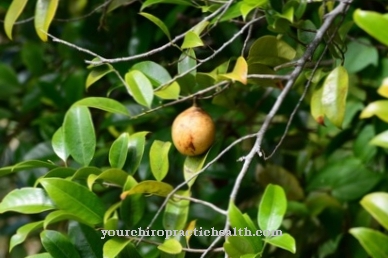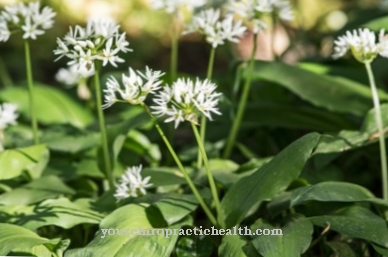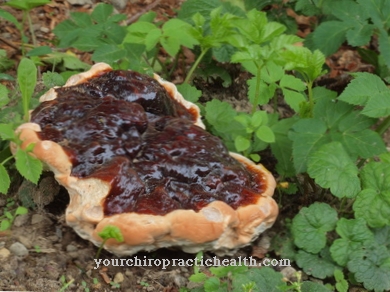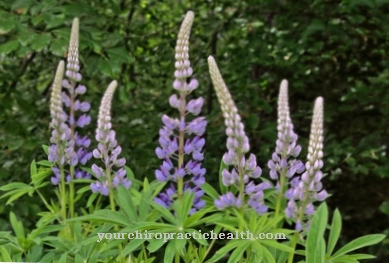Of the Dyer's gorse is one of the medicinal plants that should be used with extreme caution. For this reason, the yellow flowering plant is very rarely used today, although its effect on various types of diseases has been proven. Depending on the area of application, it is therefore often replaced by dandelion, birch leaves and similar other medicinal herbs.
Occurrence and cultivation of dyer's gorse

The entire, dark green leaves of the dye herb have a lancet-like shape. In addition, the medicinal plant forms short, awl-shaped stipules. It is in full bloom from May to August: its hermaphroditic yellow panicles are up to 6 cm long. Each individual flower measures around 1.5 centimeters. After flowering, tiny seeds ripen in the black pods, which are released when the pods burst.
The dyer's gorse was already known to the Romans: they used yellow luteolin and genistein to dye wool and linen. The versatile subshrub grows in many parts of Europe up to 1800 meters and prefers the loamy, lime-poor soils of dry meadows, dry forests and heaths. However, it does not occur at all in the Alps, Spain, Greece, Ireland and Scandinavia.
Effect & application
As a natural medicinal plant, the dyer's gorse is controversial. It contains very small amounts of alkaloids such as cytisine, anagyrin, lupanine, N-methylcitisin, sparteine, isosparteine, flavonoids, isoflavones (genistein) and small traces of tannins and essential oils. Wild gorse officially belongs to the poisonous plants, since most of its parts are weakly poisonous. Only the herb that is harvested during the flowering period can be used safely.
It is advisable to take the advice of a knowledgeable phytotherapist for the correct dosage. If the user accidentally consumes toxic components of the plant, vomiting usually occurs. In this way, the toxins are quickly excreted, so that worse consequences are avoided. If the user cannot vomit then, he should contact the poison emergency number as soon as possible.
Wild gorse is only used internally: it is drunk as a tea or used together with other medicinal herbs as a herbal tea mixture for healing, alleviating and preventing diseases. If it is to be consumed as tea, the user may only use the dried branches that were cut off at the time of flowering. To make Dyer's gorse tea, he pours 1 teaspoon of dried herb with 1/4 liter of cold water, lets it boil and then strains it off. The quarter liter of tea is then drunk in sips throughout the day.
As part of a herbal tea mixture, yellow cabbage as bladder and kidney tea or together with lady's mantle and red clover helps against health disorders that occur during menopause. To lower blood pressure, the user drinks it together with horehound, peppermint, mistletoe, arnica, barberry and goat's rue.
Homeopathy only uses the fresh shoots, flowers and leaves in extremely diluted concentrations as mother tinctures. If you accidentally overdose while preparing the tea, diarrhea and slight symptoms of paralysis will result. There are no known interactions with other agents in the dyeing gorse. However, the medicinal herb should not be consumed during pregnancy and breastfeeding, as it could possibly have a damaging effect on the embryo or infant.
Importance for health, treatment & prevention
Dye gorse has a broad spectrum of activity. Its draining and digestive properties have been secured through centuries of use. Used as a diuretic, it helps to cure diseases such as kidney and bladder semolina, urinary stones, bladder stones, urinary tract infections, edema, rheumatism and gout. The wild gorse is also used preventively for these health disorders.
Used as a remedy for constipation, it has a blood purifying, detoxifying and purifying effect. Naturopathy has long known and confirmed by recent studies that the dried herb of the dyeing gorse protects against osteoporosis and other bone diseases. The contained phytoestrogen genistein reduces the estrogen dominance and at the same time the associated breakdown of bone tissue. In order to prevent the breakdown of bone density that occurs at the beginning of menopause, the old herbal remedy is usually combined with lady's mantle, which has a similar effect to progesterone.
Recent research suggests that the genistein also has a breast cancer preventive effect, as it docks with the estrogen receptors of the breast cancer cells. In addition, the isoflavones contained in wild gorse regulate the thyroxine level in the blood. In this way it helps prevent and cure thyroid diseases.
Since genistein has an estrogen-like effect in human blood, it compensates for an estrogen deficiency: It helps with irregular menstruation and with amenorrhea (complete absence of menstrual bleeding). The dyer's gorse is also used for mild heart problems: the sparteine it contains has a strengthening effect on the heart, especially after a long illness. It also regulates low blood pressure and stimulates the circulation.
In homeopathy, the dye herb is used against headaches, irritable bowel syndrome, diarrhea and itchy skin rashes. It reduces the excess stomach acid that causes heartburn and stomach pain.



























